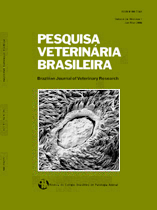 |
|
|
|
Year 2013 - Volume 33, Number 1001
|

|
Anatomical and histological characteristics of teeth in agouti (Dasyprocta prymnolopha Wagler, 1831), 33(Supl.1):51-57
|
ABSTRACT.- Silva D.C.B., Fagundes N.C.F., Teixeira F.B., Penha N.E.A., Santana L.N.S., Oliveira A.C.M. & Lima R.R. 2013. Anatomical and histological characteristics of teeth in agouti (Dasyprocta prymnolopha Wagler, 1831). Pesquisa Veterinária Brasileira 33(Supl.1):51-57. Laboratório de Biologia Estrutural e Funcional, Instituto de Ciências Biológicas, Universidade Federal do Pará, Rua Augusto Correa 1, Guamá, Belém, PA 66075-900, Brazil. E-mail: rafalima@ufpa.br
The agouti species Dasyprocta prymnolopha (D. prymnolopha) is a medium-sized rodent, diurnal, and characteristic of northeastern Brazil, south of the Amazon. Several studies have been made on these rodents. However, there is a lack of analysis of masticatory system, in particular morphology of the teeth. Thus, this research seeks to describe anatomical and histological aspects of the agouti teeth. For this purpose, we used adult agouti, in which measurements and descriptions of teeth and dental tissues were made. It was observed that the dental arch of D. prymnolopha comprises of twenty teeth, evenly distributed in the upper and lower arch, being inferior teeth larger than their corresponding higher. The incisors are larger, and between the posterior premolars and molars, there is a gradual increase in length in the anterior-posterior arch. In microscopic examination, a prismatic appearance was observed consisting of enamel prisms arranged in different directions, behind the enamel and dentin with standard tubular dentinal tubules with variable diameter and far between, also showing a sinuous path from the inner portion to the junction with more superficial enamel. Morphological analysis of dental tissues showed that an enamel with structural organization adapted to the act of chewing and high impact dentin compatible with standard tubular function resilience and mechanical damping of masticatory forces, as found in larger animals, confirming the understanding of eating habits that define much of its ecological functions within the ecosystem they inhabit. |
| |
|
|
| |
|
 |